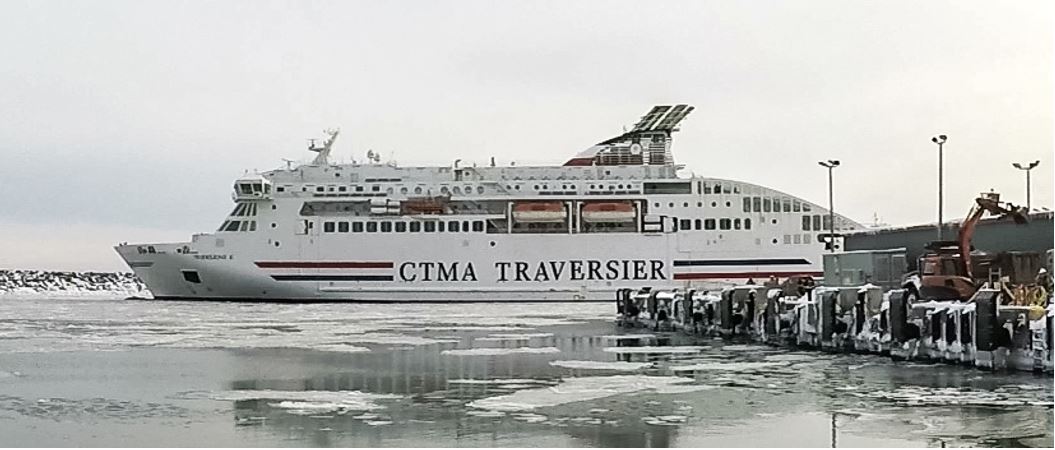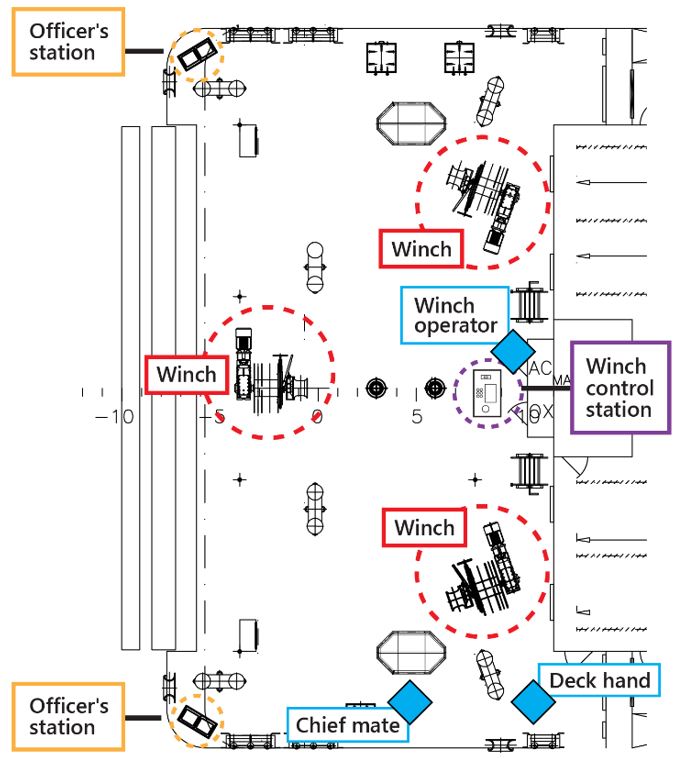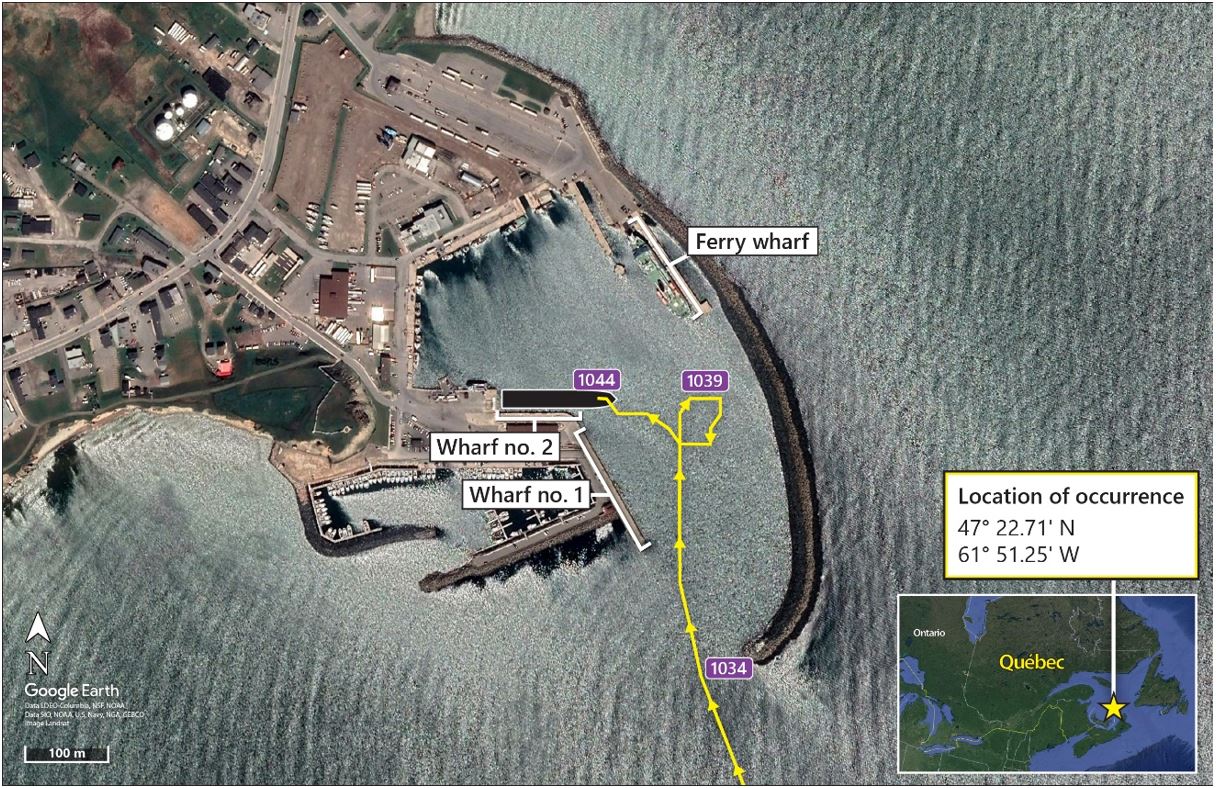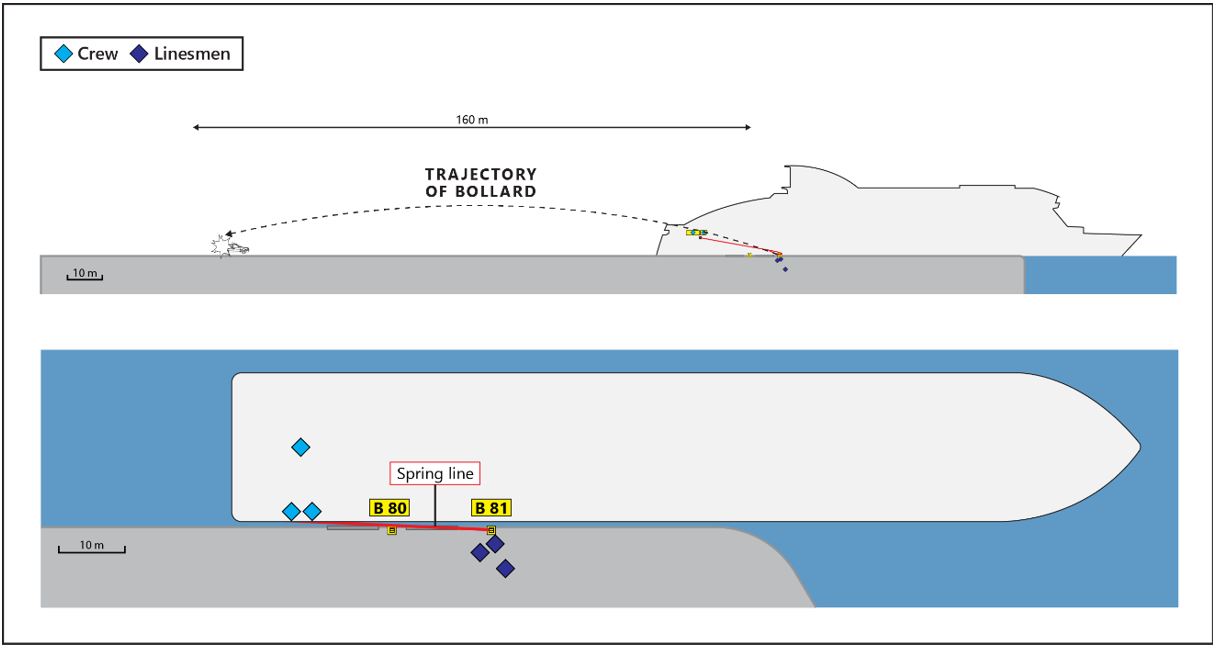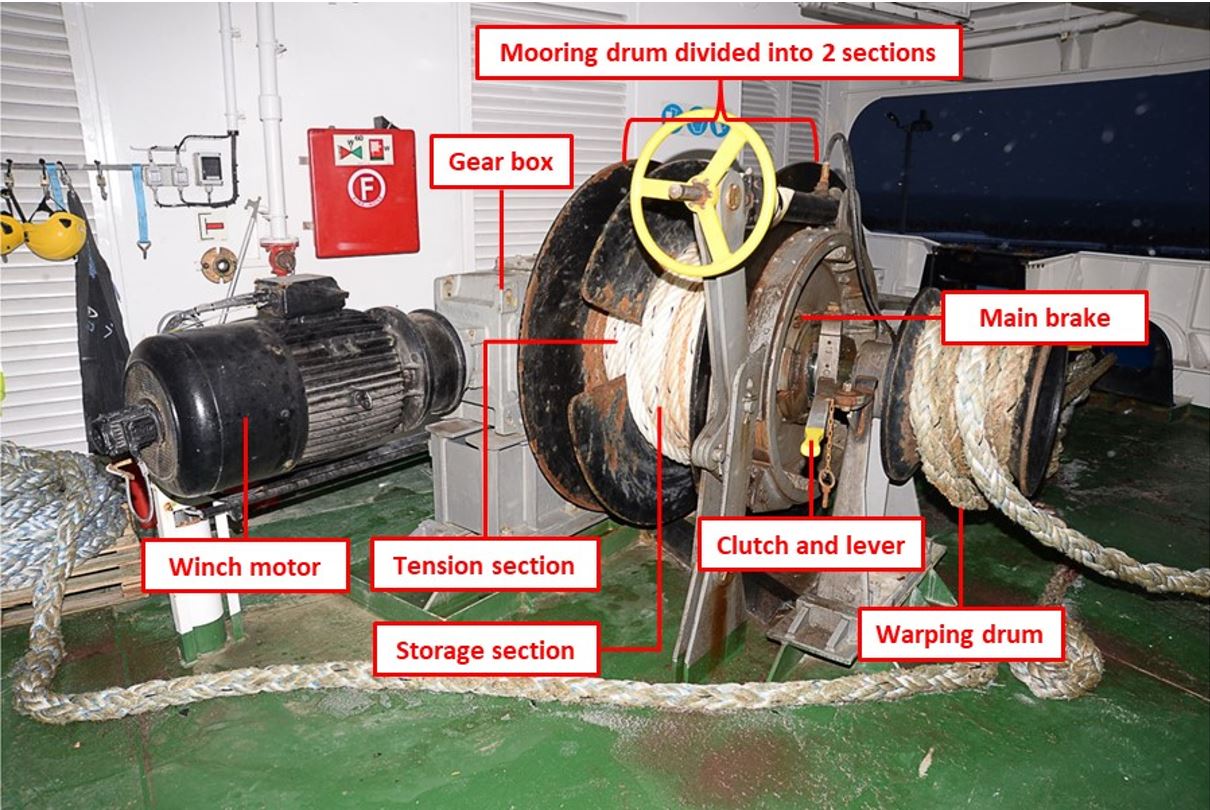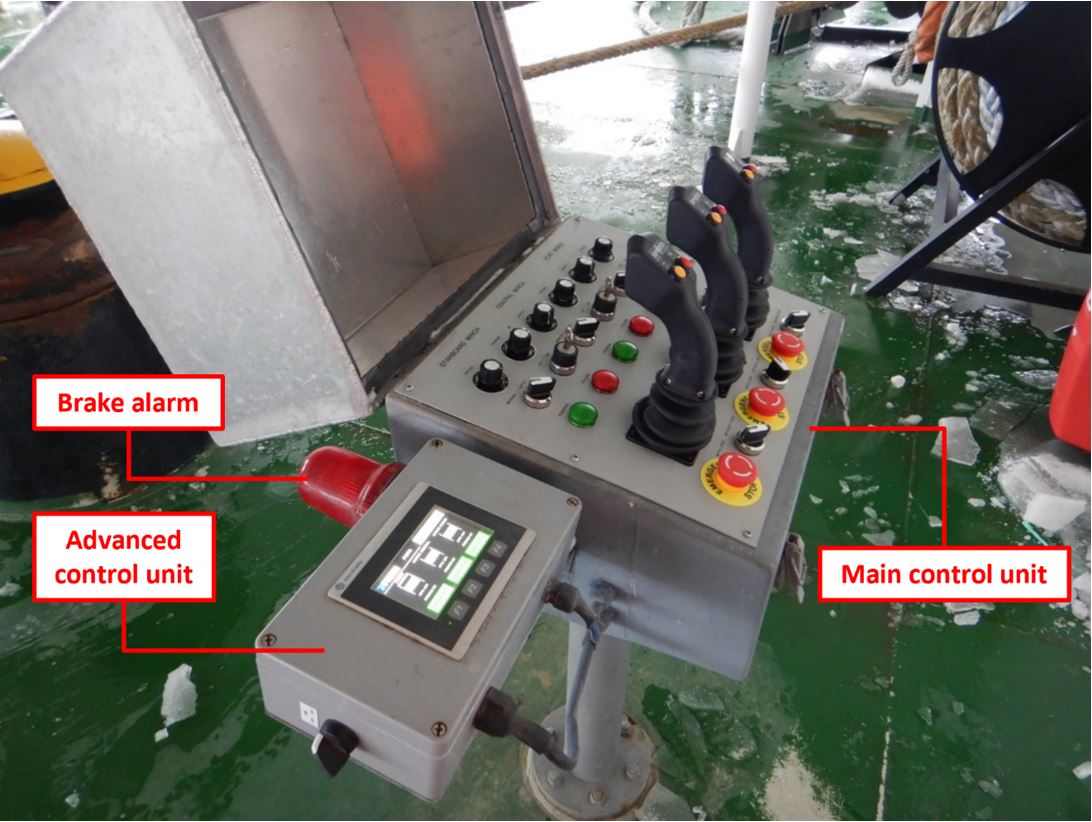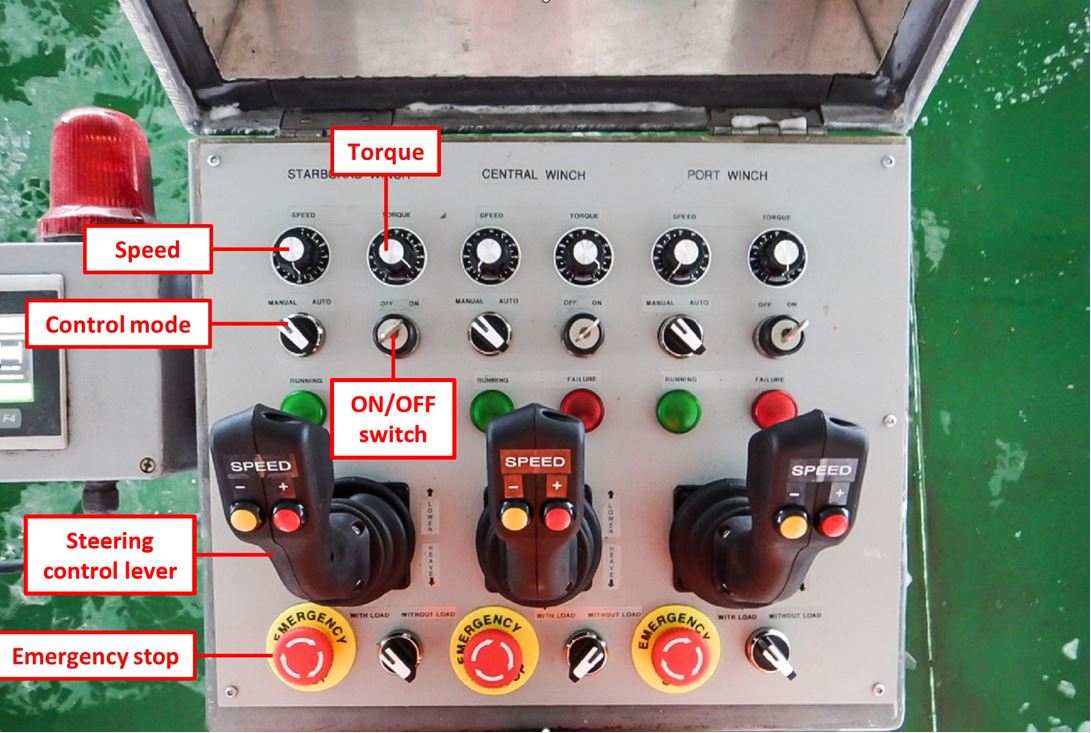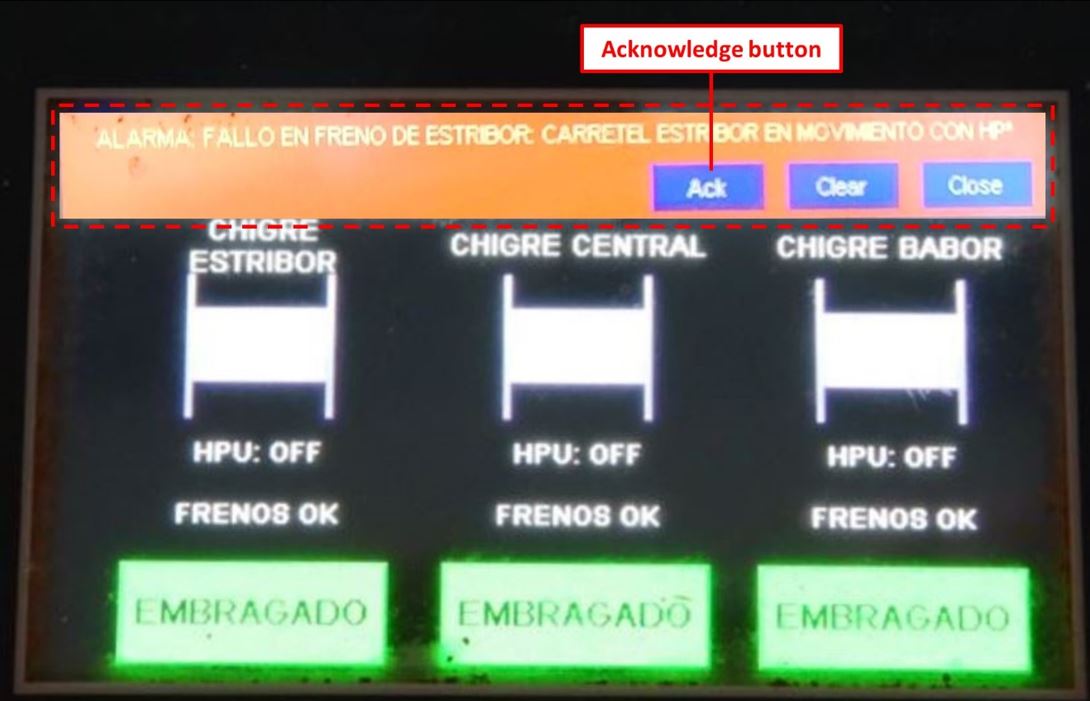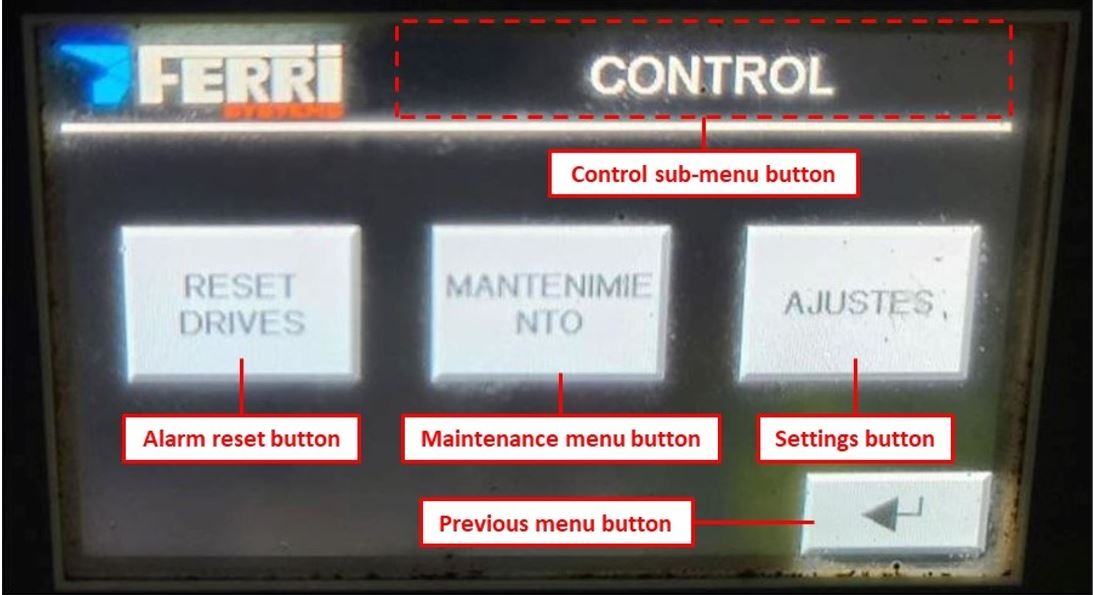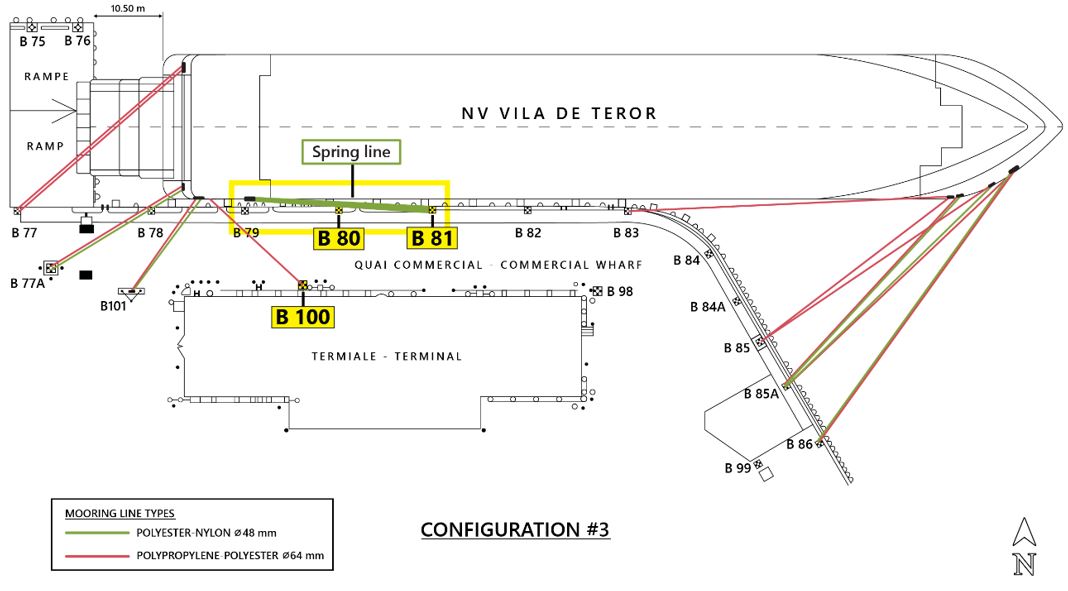Mooring accident
Roll-on/roll-off ferry Madeleine II
Cap-aux-Meules, Quebec
The Transportation Safety Board of Canada (TSB) investigated this occurrence for the purpose of advancing transportation safety. It is not the function of the Board to assign fault or determine civil or criminal liability. This report is not created for use in the context of legal, disciplinary or other proceedings. See Ownership and use of content. Masculine pronouns and position titles may be used to signify all genders to comply with the Canadian Transportation Accident Investigation and Safety Board Act (S.C. 1989, c. 3).
Summary
On 09 January 2022, the chief mate on the roll-on/roll-off ferry Madeleine II was fatally injured during a mooring accident while the ferry was docking at wharf No. 2 in the Cap-aux-Meules harbour, Quebec. There was no damage to the vessel, and no pollution was reported.
1.0 Factual information
1.1 Particulars of the vessel
| Name of the vessel | Madeleine II |
|---|---|
| International Maritime Organization number | 9430105 |
| Official number | 844246 |
| Port of registry | Ottawa, Ontario |
| Flag | Canada |
| Type | Roll-on/roll-off ferry |
| Gross tonnage | 15 875 |
| Length overall | 139.1 m |
| Draft | 5.9 m |
| Built | 2019, Factorías Vulcano, S.A., Vigo, Pontevedra, Spain |
| Propulsion | Two 4-stroke 8-cylinder diesel engines (20 000 kW in total) driving 2 variable-pitch propellers |
| Certified maximum capacity | 1406 people (1375 passengers + 31 crew members) |
| Registered owner and authorized representative | Minister of Transport |
| Technical manager and operator | C.T.M.A. Traversier Ltée. |
| Recognized organization and issuing authority for International Safety Management certification | Lloyd’s Register |
1.2 Description of the vessel
The Madeleine II is a roll-on/roll-off ferry made of steel (Figure 1) with 10 decks, including 3 car decks. Car deck 3 is accessed from the bow and stern through doors and ramps.
The bridge, which includes all the navigation and communication equipment, is located forward.
The vessel is powered by two 8-cylinder 4-stroke diesel engines with a combined maximum continuous output of 20 000 kW at 600 rpm, driving controllable-pitch propellers. The Madeleine II is equipped with 2 bow thrusters, each rated at 1000 kW. It is steered by 2 Becker-type rudders Footnote 1 with a maximum rudder angle of 60°.
The vessel has 2 mooring stations: 1 forward of the accommodation on the forecastle deck and 1 at the stern on deck 5, each equipped with 3 Carral Marine Technology CH-3715 winches. Two of the winches on the forward mooring station are also equipped with a windlass.
The Madeleine II’s mooring lines are made of 56 mm 6-strand mixed polymer ropes and have a certified minimum breaking load of 73 metric tonnes. Footnote 2 At the time of the occurrence, the 2 lines being used as aft spring lines were in good condition with no apparent defect.
1.2.1 Aft mooring station
The aft mooring station (Figure 2), completely covered by a steel roof, comprises 2 winches installed on either side of the vessel and a 3rd installed in the centre of the deck near the aft bulwark. The winch control station is located in the middle, near the accommodation area. Two positions, which are elevated and protected by steel walls, one on each side of the vessel aft, are provided for the officer in charge.
1.3 The Coopérative de Transport Maritime et Aérien
The Coopérative de Transport Maritime et Aérien (CTMA) is a transportation company that was created in 1944 to link the Îles de la Madeleine, Quebec, to the rest of Canada. The ferry service is essential to the Îles de la Madeleine community, both in terms of public safety and the provision of goods and services. The CTMA is managed on behalf of its members by the Board of Directors, headed by the Chairman. The CTMA’s head office is located in Cap-aux-Meules, Îles de la Madeleine.
In addition to transporting goods, the CTMA provides ferry service between Cap-aux-Meules and Souris, Prince Edward Island. Depending on the season, the ferry makes a number of trips a week between these 2 ports.
1.3.1 Acquisition of Villa de Teror
In February 2021, the Canadian government acquired the ferry Villa de Teror to replace the ferry Madeleine, which had reached the end of its service life. When the Villa de Teror was acquired, the future crew and several additional CTMA employees were sent to Spain, where the vessel had just been commissioned, to familiarize themselves with the vessel. The vessel was delivered to Canada in late March 2021 and entered service on 01 June 2021 under the name Madeleine II.
The Madeleine II measures 139.1 m, compared with the Madeleine, which measured 116.24 m.
1.4 Port infrastructure
1.4.1 Description
The port facilities at Cap-aux-Meules, the main commercial port of the Îles de la Madeleine, are under the authority of the federal government. Since the 1970s, these facilities have been used by various types of commercial vessels, including ferries, passenger vessels, oil tankers, and other cargo vessels.
The facility comprises several wharves, including one specially designed for ferry service. The ferry wharf has an access ramp for loading and unloading vehicles. At the time of the accident, this wharf was unusable due to upgrades being performed under the federal government to accommodate the Madeleine II.
Wharves no. 1 and no. 2 are designed to accommodate commercial vessels. Wharf no. 2 is equipped with an access ramp and is approximately 82 m long, while the overall length of the ferry is 139.1 m.
At the time of the accident, with no other suitable commercial port facilities available, the only option was to to temporarily use wharf no. 2 for the ferry service. When moored at wharf no. 2, approximately 57 m of the Madeleine II’s bow extended past the end of the wharf. For this reason, no head lines could be deployed, and only aft spring lines could prevent the vessel from moving astern.
Any wharf rehabilitation work that Transport Canada (TC) wants to carry out exceeding 1 million dollars must go through the full process of the Public Services and Procurement Canada (PSPC) Project Navigator. Footnote 3 The bidding process for the work is complex, which can cause delays in starting construction work. The COVID-19 pandemic has also slowed work on upgrading the ferry wharf.
1.4.2 Bollard condition surveys
In November 2018, while the CTMA Vacancier was moored at wharf no. 2 in Cap-aux-Meules, the B80 mooring bollard broke under the tension of the mooring line. Footnote 4 The B80 mooring bollard was replaced, using the existing anchorage, with another bollard on wharf no. 2 with the same capacity. An engineering firm carried out a technical study of the incident and determined that the bollard failure was probably caused by overloading; according to the manufacturer’s drawing, the B80 bollard had a capacity of 25 tonnes. Given the environmental conditions and the ship’s dimensions, the forces acting on the bollard exceeded its maximum working load.
As a result of the B80 mooring bollard incident, and to prepare for the arrival of the Madeleine II in 2021, surveys were conducted of the bollards at the Cap-aux-Meules port facilities.
In April and November 2020, because the condition of the bollards had deteriorated, inspection of the 68 mooring bollards on wharves no. 2 to no. 8 in the port of Cap-Aux-Meules was carried out by another engineering firm. Its mandate included assessing the residual capacity of the bollards. Although the bollards’ design capacity was 25 tonnes, the study recommended reducing the capacity of certain bollards. The capacity of bollard B80 was reduced to 10 tonnes, and that of bollard B81 to 20 tonnes. It was recommended to TC that bollards B80 and B81, as well as their anchoring, be completely replaced.
In November 2020, after bollards B78 and B80 showed signs of movement, an additional inspection of both bollards was carried out, and the immediate decommissioning of bollard B80 was recommended and carried out.
1.4.3 Work on the ferry wharf and wharf no. 2
1.4.3.1 Work on the ferry wharf
There are 2 upgrade projects for the ferry wharf to accommodate the Madeleine II. The dock work is being managed by PSPC on behalf of TC.
The 1st project began in early summer 2021 and involves replacing the existing vehicle access ramp with one adapted to accommodate the Madeleine II ramp.
The 2nd project began in early winter 2022 and includes building a new mooring dolphin, reinforcing the wharf structure, and replacing and upgrading the existing mooring bollards and fenders.
TC’s Atlantic Region office in Dartmouth, Nova Scotia, is responsible for these projects.
Work on both projects is being carried out by the same New Brunswick construction company. The 1st project was scheduled for completion in fall 2021, and the 2nd in May 2022. Work has not progressed as planned, for the reason, the completion date has been pushed back. However, the Madeleine II was able to return to the ferry wharf in November 2023.
PSPC has an on-site inspection contract for the duration of the projects to monitor all aspects of the work.
1.4.3.2 Work on wharf no. 2
TC’s Quebec Region office is responsible for the other port facilities at Cap-aux-Meules. Following the decommissioning of the B80 bollard in November 2020, PSPC and TC began planning work to replace the B80 bollard with a 25-tonne mooring bollard. Just as the planning was nearing completion, SPAC and TC were informed that the foundation of bollard B80 had become unstable. As a result, the work schedule had to be revised.
For its part, the CTMA, in anticipation of the Madeleine II’s entry into service and to accelerate work, asked the federal government to authorize it to take over certain project responsibilities, such as replacing bollards B80 and B100 with 75-tonne mooring bollards. Following this request, on 10 December 2021, TC authorized the CTMA and its subcontractors to replace these 2 mooring bollards. A local firm performed the work under CTMA supervision; the work began on 03 January 2022 and was completed in April 2022.
1.5 History of the voyage
On 09 January 2022 at 0620, Footnote 5 the Madeleine II left Souris with 41 crew and 71 passengers on board for its return trip to Cap-aux-Meules.
Approximately 5 nautical miles off Cap-aux-Meules harbour, crew members were informed of the mooring plan and told to prepare for the ferry’s docking.
At 1034, the vessel entered the port (Figure 3), and its speed was reduced to 4.1 knots. The bow and stern mooring teams went to their respective stations. The third officer was in charge of the forward mooring station, with the bosun operating the winches, plus 2 deckhands and 1 deck cadet to look after the mooring lines. The chief mate was in charge of the aft mooring station, assisted by a winch operator Footnote 6 and a 2nd deckhand to handle the mooring lines. The second officer was at the vehicle loading ramp controls at the stern of deck 3. The chief mate, second officer, and third officer communicated with the master via portable ultra-high frequency (UHF) radiotelephones. The master informed the mooring crews that the forward breast line and 2 aft spring lines would be deployed first.
Meanwhile, ashore, a team of 6 linesmen made its way to wharf no. 2. Three of the linesmen were responsible for seizing the stern mooring lines and placing them on the mooring bollards as ordered by the master via radiotelephone. The other 3 were in charge of the forward mooring lines.
At approximately 1039, the vessel had completed its turning circle, and the master began the final approach to wharf no. 2, with the starboard side of the vessel parallel to the dock and its stern towards the access ramp. The vessel was moving astern at a reduced speed of 1.5 knots. The chief mate informed the master when the stern of the vessel passed through the corner of the wharf.
At 1043, the deckhand in charge of the stern lines deployed the 1st spring line through the roller chock on the starboard quarter. The 1st spring line was unwound from the winch, that was being operated manually, as the vessel moved astern. The linesmen on the wharf picked up and placed the eye of the spring line on mooring bollard B81. The chief mate then informed the master that this had been done. The chief mate then deployed the 2nd spring line, which had been placed on the deck earlier. The linesmen on the wharf picked it up and began pulling it onto the same mooring bollard as the 1st spring line.
At approximately 1044, the 1st spring line began to come under tension. A 1st winch control alarm activated. A 2nd alarm soon activated, and the winch stopped operating. The winch operator tried to reset the alarm on the touch screen to regain control of the winch and release the spring line. The winch operator tried to warn the chief mate of the situation but had momentarily lost visual contact with the chief mate and the other deckhand. The chief mate had bent over and was no longer visible behind the winch drum. When the deckhand responsible for handling the mooring lines saw the tension building up on the 1st spring line, he moved away from the bulwark to protect himself behind the corner of the superstructure.
The linesmen on the wharf were preparing to place the 2nd spring line on bollard B81. A few seconds later, the chief mate stood upright behind the bulwark. At that moment, the mooring bollard snapped, and the 1st spring line suddenly snapped upwards in a whip-like movement. The 1st spring line flew high above the bulwark on deck 5 and struck the chief mate. The chief mate, who was not wearing a safety helmet, was hit on the head and fell unconscious on impact. Part of the bollard was thrown almost 160 m back from the wharf toward the parking area, where it hit a truck and came to rest a few metres away from the truck (Figure 4).
The deckhand in charge of handling the mooring lines informed the captain of the accident. The master brought the propeller pitch engine telegraph to the full ahead position to stop the vessel. At this point, the Madeleine II was moving astern at a speed of approximately 1.0 knots. Moments later, the captain ordered the second officer up on deck 5 to ascertain the situation and take charge of operations at the aft mooring station.
At 1045, the vessel hit the wharf access ramp and came to a stop. The 2nd spring line, which had been placed on the deck, had slipped into the water and was wrapped around the vessel’s starboard propeller. Footnote 7 The winch operator tried to wind up the 1st spring line, but it was not winding in the right direction on the drum.
The master decided to berth the vessel at wharf no. 1. He also contacted emergency services, company management, and vessel traffic to inform them of the accident.
At the same time, the crew administered first aid to the unconscious first officer, including cardiopulmonary resuscitation. They were joined by a doctor who was among the passengers. Shortly thereafter, the doctor pronounced the first officer dead.
Between 1050 and 1053, as the vessel was moving toward wharf no. 1, paramedics and police arrived on the scene.
At approximately 1130, after the Madeleine II had been moored at wharf no. 1 and a gangway had been installed, paramedics, the Sûreté du Québec, the CTMA operations manager, the vessel’s other chief mate, the purser, and the psychosocial team from the Centre intégré de santé et de services sociaux des Îles de la Madeleine boarded the vessel.
At approximately 1245, when some of the Sûreté du Québec’s work had been completed, the vessel returned to wharf no. 2.
At around 1325, with the help of 2 tugs, the Madeleine II was moored at wharf no. 2, and the crew proceeded to disembark the passengers and vehicles.
1.6 Environmental conditions
At the time of the occurrence, the wind was coming from the south-southwest at 15 knots. The air temperature was −1 °C. The sky was overcast, and visibility was 10 nautical miles.
1.7 Vessel certification
The Madeleine II had all the required equipment and certificates for a vessel of its class and for the intended voyage. Its last periodic (annual) inspection was carried out on 19 May 2021 by Lloyd’s Register, its recognized organization.
1.8 Personnel certification and experience
The master held a Master, Near Coastal certificate of competency. He joined the CTMA in July 1981 as a deckhand, and in 1992 began working in various deck officer positions. In 1995, he was promoted to master and worked on several CTMA vessels. In March 2021, he took command of the Madeleine II.
The chief mate held a Chief Mate, Near Coastal Certificate, issued in May 2019. He joined the CTMA in February 2017 as helmsman and was promoted to deck officer a few weeks later. In April 2018, he became relief chief mate. In October 2019, he secured a permanent position with the CTMA and acted as relief chief mate on the Madeleine II and CTMA Voyageur 2.
The second officer held a Chief Mate, Near Coastal Certificate, issued in January 2020. He joined the CTMA in 2018 as a mate after completing his studies in navigation.
The deckhand who operated the aft mooring winches started sailing in 2010 as a cook. He joined the CTMA in 2014 as a cook. In 2020, he began working as a deckhand on CTMA vessels, then on the Madeleine II since it was acquired in 2021.
The deckhand who handled the stern lines began sailing fishing vessels in 1992. He joined the CTMA in 2015 as a deckhand. He began working on the Madeleine II when it was acquired in 2021.
1.9 Safety during mooring operations
1.9.1 Hazards associated with mooring operations
The main hazards to personnel involved in mooring operations are as follows:
- Snap-back when a taut mooring line breaks or releases from any obstacle Footnote 8
- Getting feet or hands caught in mooring lines or between mooring lines and mooring points Footnote 9
- Falls Footnote 10
A number of factors can increase the risk of accidents during mooring operations, including poorly maintained mooring lines or equipment, a mooring station cluttered with unnecessary ropes or equipment, lines unwound directly from the winch, a line becoming entangled on the mooring winch drum, and less than adequately supervised mooring operations, such as when a supervisor is involved in other tasks during mooring operations. Footnote 11
In addition, it is common practice to operate mooring lines from winches during the dynamic phase of mooring operations. However, several TSB investigations Footnote 12 have shown that this approach increases the risk of accidents during mooring. For example, deploying mooring lines directly from a winch may not leave enough time and options to respond to a problem.
1.9.2 Marking of snap-back zones on deck
A taut mooring line that suddenly breaks or releases acts like a whip and can cause injury. The impact and inertia forces of the mooring line depend on the elasticity and strength of the material from which it is made and the tension exerted on it, while the whiplash danger zone is determined by the attachment points of the mooring line and the tension exerted on it. Footnote 13
It has been common practice in the marine industry worldwide to mark whiplash zones on the decks of mooring stations. For example, until recently, the United Kingdom Maritime and Coastguard Agency’s Code of Safe Working Practices for Merchant Seafarers (COSWP) recommended marking around critical points such as the warping drum, roller chocks, and pedestal fairlead to warn mariners to steer clear of these areas when mooring lines are under tension.
However, recent studies Footnote 14 have shown that the nature of the “snap-back” phenomenon is more complex than initially believed. This is due to factors such as berth configuration and the type and material of mooring line used (its elasticity and breaking strength).
The latest version of the COSWPFootnote 15 now discourages the marking of snap-back zones on deck. The Code recommends that the entire mooring deck be considered a snap-back zone and that clear and visible signage be posted to alert the crew. It is also recommended that a bird’s-eye view illustration of the berth be produced to identify potentially hazardous areas. Footnote 16
Finding: Other
At the time of the occurrence, the potentially hazardous areas or snap-back zones at the mooring stations featured no visible markings or signage.
1.10 Ergonomic design of systems and equipment
Ergonomic design of systems and equipment is a user-centered design approach intended to optimize the interaction between users and their technical environment. This approach strives to develop intuitive interfaces and reduce mental and physical load while advancing safety by reducing the risks associated with human error.
There are many standards and recommended practices for the design of specific components: for example, control stations, consoles (computerized or other), and wired panels. The American Society for Testing and Materials (ASTM) has published a guide to the design of marine systems, equipment and facilities. This document aims to enable the design of a user-friendly system that meets the user’s needs and constraints, both internal (e.g., physical and cognitive constraints) and external (e.g., the environment and time pressures). It includes the following ergonomic principles:
- “The content of information displayed to an operator shall allow the operator to perform the intended mission, but shall be only limited to that which is necessary to perform specific actions or to make decisions.”Footnote 17
- “Controls shall be placed so that simultaneous operation of two controls will not require a crossing or interchanging of hands.”Footnote 18
- “All controls shall be operable by personnel wearing both normal clothing and personnel protective equipment (PPE) such as boots, gloves, and hazard material clothing.”Footnote 19
- “Danger and caution signals shall be immediately and easily discernible from each other and shall be consistently applied for all alarms.”Footnote 20
- “Controls shall be designed and located so they are not susceptible to accidental activation. Acceptable methods to reduce the likelihood of accidental activation include: […] Restricting access to controls by isolating them or by providing a cover guard or physical barrier.” Footnote 21
1.11 Winches on the aft mooring station
1.11.1 Winch components
The winch consists of an electric motor connected to a drive shaft via a gearbox. The drive shaft passes through a mooring drum divided into 2 sections (1 section for storage and 1 section for tensioning) and a warping drum (also known as a capstan head) at the outer end. A lever engages and disengages the mooring drum. The warping drum cannot be disengaged from the shaft. When the vessel is moored, the winch motor is switched off and the electromagnetic brake is applied. The main friction band brake is automatically activated through a hydraulic cylinder to immobilize the winch drum and secure the mooring lines. The shaft can then be disengaged in order for a 2nd mooring line to be used with the warping drum (Figure 5).
Electric motors are fitted with automatic electromagnetic brakes on the drive shaft to prevent the motors from freewheeling when the power is cut. Footnote 22 The electromagnetic brake is located in the electrical motor mount, near the fan.
The operator controls the winch’s speed and direction of rotation using the controls on the main control unit at the winch control station.
When the CTMA took ownership of the vessel in March 2021, it obtained the technical documentation for the winches; however, there was no user manual. The Spanish crew provided the CTMA employees with a demonstration of the winches’ functionality and alarms, as well as the process of restarting the winches in the event of failure. The CTMA employees also had the possibility of familiarizing themselves with the equipment under the supervision of the Spanish crew.
1.11.2 Control station components
The winch control station comprises 2 units: the main control unit and the advanced control unit (Figure 6).
1.11.2.1 Main control unit
The control unit is divided into 3 sections, one for each winch. Each section contains controls for the winch’s direction of rotation, speed, and torque; indicator lights showing the status of the winch (RUNNING or FAILURE), and an emergency shutdown button (Figure 7). The 3 emergency shutdown buttons are not covered by a protective channel or cover.
The rotation direction of each winch drum is controlled by a joystick. Footnote 23 Speed is controlled either by the buttons on the joystick or by an control knob.
Torque can be controlled in manual or automatic mode, using a switch to select the desired operating mode. In manual mode, torque is controlled by the operator using the control knob. In automatic mode, the operator selects a desired torque level using the control knob. Torque increases gradually and automatically until the selected value is reached. Footnote 24
1.11.2.2 Advanced control unit
All winch motor control and protection functions are managed by a smart power and motor control centre. This control unit has been programmed with operational, statistical, and diagnostic data and organizes communication data between the automation system and the motor feeder. This enables it to detect abnormal conditions or potential risks to motors and operators.
When the control centre detects an anomaly, it notifies the operator via the advanced control unit. The advanced control unit (Figure 8) consists of a touch screen to the left of the main control unit. At the time of the accident, the interface of the advanced control unit was in Spanish. It comprises 5 touch screen buttons: 2 buttons for accessing the control menu and status menu, and 3 buttons for engaging and disengaging the winches (one button per winch).
When the winches are operational, the engaged and disengaged buttons are illuminated green. When the winches are malfunctioning, the buttons are illuminated red.
1.11.3 Alarms
The advanced control unit has 2 alarm levels. When an anomaly is detected, a 1st alarm is triggered: the operator is warned by an alarm message in Spanish, an audible signal, and the flashing brake alarm light (Figure 6).
This alarm does not deactivate the winch. The engaged/disengaged button for the winch remains green. To stop the 1st alarm, the operator must press the “Ack” (acknowledge) button on the advanced control unit, which returns the display to its initial menu (Figure 9).
The 2nd alarm is triggered when the parameters of the anomaly have reached a certain level preset in the system, and the winch will stop operating. This function is designed to protect the winch motor.
The operator is alerted by an audible signal and the flashing brake alarm light. The FAILURE light of the affected winch also lights up on the main control unit. To reactivate the winch, the operator must press the control menu on the advanced control unit and access the submenu. In the submenu, the operator must press the alarm reset button. To return to the previous menu and resume winch operation control, the return button must be pressed. If the anomaly is still present, the alarm will reset until the problem is resolved (Figure 10).
From their position in the starboard corner of the vessel, the officer can see that a brake alarm has gone off but cannot tell whether it is the 1st or 2nd alarm.
Since the acquisition of the ferry, the winch alarms had activated occasionally with no negative consequences, because the winch operator was able to reset the alarm.
1.12 Mooring the Madeleine II
At Souris, the Madeleine II berths on its starboard side, with the bow facing the wharf access ramp, and uses the bow ramp for unloading and loading vehicles. At Cap-aux-Meules, the vessel also berths on its starboard side but with the stern facing the wharf access ramp.
At approximately 5 nautical miles before the arrival of the Madeleine II at a port, the mooring plan is shared with the crew.
On arrival, the chief mate’s role is to supervise operations at the berth of the vessel approaching the dock first. The chief mate must periodically inform the captain of the distance between the vessel and the dock.
In preparation for berthing, the deckhands prepare the mooring lines: spring lines, breast lines, head lines, and stern lines. They start by unwinding some of the mooring lines from the winch drums and laying them on deck. They then pass the eye of each mooring line through the roller chocks and attach mooring line throwers, ready to throw them to the wharf. Finally, they place the additional mooring lines on deck to secure the vessel once it has reached its final position, at the very end of the berthing manoeuvre.
The master and the officers communicate with each other via portable UHF radiotelephones. The crew and linesmen communicate with each other via portable UHF radiotelephones or verbally.
1.12.1 Mooring at Cap-aux-Meules
On final approach to Cap-aux-Meules, the chief mate goes to his designated post (Figure 2) to supervise operations from the stern deck. The chief mate coordinates the deckhands’ actions and communicates with the master to keep him informed of operations and the distance between the vessel’s stern and the wharf access ramp. One deckhand is positioned at the winch control station, and another to handle the mooring lines.
The winch operator is responsible for controlling the tension of the mooring line. Because the mooring line should never be fully tensioned until the vessel is in its final position, the winch operator follows the mooring crew’s instructions to adjust the winch speed according to the tension of the mooring line. The deckhand on the mooring line communicates with the winch operator using standard gestures, sometimes combined with verbal commands. The operator must also monitor the line on the drum to ensure that it doesn’t become tangled and that it unwinds correctly.
On the wharf, the linesmen team is composed of 6 people: 3 linesmen who manually handle the mooring lines at the bow of the vessel and 3 at the stern. For each team, one mooring line is handled at a time and placed on the bollard according to orders from the vessel.
On approach to the wharf ramp, under the command of the chief mate, the deckhand at the mooring line deploys the 1st spring line. The linesmen on the wharf pick up the spring line and place it on a bollard. The deckhand then signals the winch operator to start unwinding the mooring line. The spring line is slowly unwound from the winch drum, and the deckhand watches it to ensure it does not become taut. The deckhand instructs the operator to increase or reduce the winch speed to keep the tension low until the vessel comes to a stop. Meanwhile, the chief mate monitors operations and informs the captain of the distance remaining between the stern of the vessel and the wharf ramp.
Once the vessel has come to a stop, the spring line on the mooring drum is tensioned with the winch and locked with the main brake. The mooring deckhand then releases the other 2 mooring lines on the other winches, one after the other. These are then tensioned and secured using the main brake for each winch. The mooring deckhand deploys a 2nd spring line. The 2nd spring line is tensioned using the winch’s warping drum and then transferred to the vessel’s mooring bitt. A 2nd mooring line is then deployed in the same way from each of the other 2 winches. Additional mooring lines may be required, depending on the duration of the stop in port and the expected weather conditions.
If the master considers the weather conditions are favourable, they may decide to deploy the 2nd spring line at almost the same time as the 1st spring line. This method requires the help of a 3rd deckhand. When the 1st spring line is placed on the bollard, the 3rd deckhand Footnote 25 deploys the 2nd spring line, which is placed on a bollard on the wharf by the linesmen ashore. This deckhand manually checks the tension of the 2nd spring line by sliding it over a bollard on deck. The tension must be identical to that of the 1st spring line. When the vessel has come to a stop, the deckhand secures the 2nd spring line to the bitt, and the mooring procedure returns to that of a single spring line. This operation saves time, because the warping drum is not required.
Under informal CTMA practice, masters could request tug assistance at wharf no. 2 when the wind was blowing at a speed of 25 knots or more from between southeast and southwest.
At this time of the accident, the ongoing work to replace the B80 bollard on wharf no. 2 made it challenging for the linesmen to move around on the wharf.
1.12.2 Mooring study of the Madeleine II at wharf no. 2
In standard vessel mooring, aft spring lines and head lines prevent the vessel from moving astern. In advance of the Madeleine II’sacquisition, and knowing that the ferry wharf would not be ready to accommodate it, the CTMA hired a consulting, engineering, and technical services firm to study the berthing and static phase of mooring at wharf no. 2. The aim was to identify critical conditions relating to the temporary use of the wharf during the ferry wharf upgrade.
The technical note produced by the consulting firm specified that the study is only intended to model certain static mooring configurations, in particular with a view to identifying corrective work requirements where necessary.
Three static mooring configurations were studied: a configuration using the B80 bollard, a configuration in which the B80 bollard was out of use and 2 mooring lines used the B100 bollard, and an optimized configuration based on the 2nd mooring configuration, where only 1 mooring line used the B100 bollard (figure 11). For all 3 configurations, there is only one spring line being used on bollard B81.
The conclusion of the mooring study was as follows [translation]:
In the absence of upgrades (configuration #3), the results indicate that the vessel MV Madeleine IIshould not be moored at wharf no. 2 in winds of 19 knots or more from the southwest (SW) to the east-southeast (ESE), and a maximum speed of 65 knots in other directions, without the compensatory measures of tension reduction by tugs, traffic management, deployment of the starboard anchor, repositioning of the vessel towards the wharf ramp and active tidal management of the ballast tanks.
To improve mooring capacity in the configurations studied, it is recommended that the B80 and B100 bollards be replaced to increase their capacity in line with operational requirements.
Any modifications to the mooring configurations invalidate the results contained in this study. Footnote 26
Despite the study’s conclusions, without the B80 bollard, the crew occasionally placed the 2 aft spring lines on the B81 bollard when warranted by the weather conditions.
1.13 Safety management
The objectives of the International Safety ManagementFootnote 27 (ISM) Code are to ensure safety at sea, prevent human injury or loss of life, and avoid damage to the environment. According to the ISM Code, a company’s safety management objectives should provide for safe practices in vessel operations and a safe working environment by assessing all identified risks to vessels, personnel, and the environment; establish appropriate safeguards against those risks; and, continuously improve the safety management skills of personnel ashore and on board vessels. The ISM Code, which applies to vessels that are subject to the International Convention for the Safety of Life at Sea (SOLAS), requires companies and vessels to develop and implement a safety management system (SMS).
At the time of writing this report, in Canada, cargo vessels that are not subject to SOLAS and that are operating on domestic voyages were not required to have an SMS. Footnote 28 However, companies that voluntarily implement an SMS may have it audited by a classification society. Upon verifying that the voluntary SMS meets the requirements of the ISM Code, and that the company and the vessel are operating in accordance with the SMS, the classification society will issue a document of compliance to the company and a safety management certificate to the vessel. TC does not provide verification or oversight of these voluntary systems.
1.13.1 Operating procedures
Operating procedures are part of an SMS and are essential to ensure the safety and efficiency of a vessel, particularly for safety-critical tasks. Properly documented procedures provide a step-by-step description of how a task is to be carried out, reducing the number of decisions operators have to make while manoeuvring. Detailed procedures improve operational safety, ensure consistency from one operator to the next, and reduce the risk of errors and omissions.
When procedures are informal, i.e., neither written down nor integrated into the safety management system, the practices become inconsistent. This is because, without a formal written standard, procedures are transmitted verbally from one operator to the next and are therefore subject to small changes from one operator to the next, which can lead to considerable divergence as the information is passed on within the team. Furthermore, over time, operators are likely to modify their practices: again, these are small changes that accumulate over time and eventually lead to a major divergence. Finally, when practices or procedures are not formalized and put down in writing, they may be seen as a suggestion rather than a requirement. Using detailed, documented procedures helps mitigate procedural drift and helps explain the risks associated with manoeuvres and how to mitigate the risks. Because operators do not have the time to carry out an exhaustive risk assessment during manoeuvres, procedures help raise operator awareness in advance and increase the safety margin.
1.13.2 CTMA safety management
The CTMA voluntarily developed an SMS for its fleet in 2003 and engaged the services of a classification firm to verify and certify its compliance with the ISM Code.
The CTMA Manuel de gestion du système (MGS) contains several policies for the fleet. This manual refers to the Manuel des opérations et procédures (MOP) for written guidelines and procedures to be followed. There is no specific manual for each vessel.
The mooring procedure for the Madeleine II was developed by the CTMA before the vessel was commissioned in June 2021. The method has never been documented in writing.
The MOP does not specify conditions requiring the mandatory use of tugs; however, it does stipulate that masters are responsible for all towing-related communications and arrangements.
The MOP contains a procedure for head protection. This procedure aims to ensure that the risk of head injury is minimized. This safety rule requires, among other things, that hard hats be worn by all employees involved in mooring operations on the wharf and outer decks of vessels, or who are exposed to the risk of having their head struck or trapped. The investigation established that, on the day of the occurrence, the chief mate, the deckhand at the aft mooring station, and one of the linesmen on the wharf were not wearing their safety helmets.
Finding: Other
On the day of the occurrence, the chief mate, the deckhand at the aft mooring station and one of the linesmen on the wharf were not wearing their safety helmets.
1.14 Supervision
Supervision is an administrative control that supports or reinforces the use of concepts taught during training, compliance with procedures, setting of priorities, maintaining an adequate workload, preventing high levels of fatigue, as well as commitment and motivation. Supervision can have a significant impact on many of the factors that influence behaviours in the workplace.
Although supervision is a key aspect of safety, its effectiveness can be compromised if a supervisor takes an active role in ongoing operations. This limits the supervisor’s ability to effectively monitor the overall operation, as their attention is focused on the tasks at hand.
Given the vast amount of information in the work environment and the fact that information processing is a continuous process, less important information must be ignored to leave room for information that is critical to the task at hand. And although it is possible for people to quickly direct their attention from one source of information to another, they can process only one source of information at a time. Performing several tasks at the same time leads to a reduction in performance for each task.
1.15 Previous occurrences
Over the years, the TSB has been informed of numerous accidents Footnote 29 in which mariners have been injured, in some cases seriously or fatally, during mooring operations.
In 2017, the TSB launched an investigation into marine occurrence M17C0060 (22 May 2017), in which the second officer of the bulk carrier Nord Québec was fatally injured in a mooring accident while the vessel was berthing at wharf no. 16 in the port of Trois-Rivières, Quebec. The investigation report provides a summary of 23 occurrences reported to the TSB over the previous 10 years involving Canadian- or foreign-flagged vessels engaged in mooring operations in Canada.
From May 2017 to March 2022, 12 occurrences (including this occurrence) involving mooring operations in Canada on domestic and foreign-flagged vessels were reported to the TSB. In these occurrences, 11 people sustained serious injuries and 2 were fatally injured. In 4 of these occurrences, taut mooring lines were involved; in 5 cases, people had one or more limbs crushed; and in 3 cases, people tripped and fell during mooring operations.
1.16 TSB Watchlist
The TSB Watchlist identifies the key safety issues that need to be addressed to make Canada’s transportation system even safer.
Safety management is a Watchlist 2022 issue. As this occurrence demonstrates, even when structured safety management processes are in place, some risks may not have been adequately assessed.
ACTION REQUIRED Safety management will remain on the Watchlist for the marine transportation sector until:
|
1.17 TSB laboratory reports
The TSB completed the following laboratory reports in support of this investigation:
- LP037/2022 – Study of winch design, operation and ergonomics
- LP041/2022 – Mooring bollard examination
2.0 Analysis
The analysis will focus on the causal and contributing factors that led to the fatal mooring accident on the Madeleine II when it arrived in the Îles de la Madeleine, Quebec. The analysis will also cover the Coopérative de Transport Maritime et Aérien’s (CTMA) safety management system for safe mooring operations; the state of the port facilities at Cap-aux-Meules, Quebec; and the design of the vessel’s mooring winches.
2.1 Mooring on the day of the accident
On 09 January, before the Madeleine II arrived at Cap-aux-Meules, the master and chief mate had agreed to use a 2nd spring line during the dynamic phase of the mooring operations, in part because of the weather conditions and the ongoing the contruction work that made it challenging to move around on the wharf. This practice required 1 deckhand per spring line, 1 deckhand at the control station, and 1 officer for supervision and communication with the master. However, in this occurrence, only 2 deckhands and 1 officer took part in the manoeuvre at the aft mooring station. The investigation could not determine why a 3rd deckhand was not on site during the mooring operations.
To compensate for the increased workload caused by the absence of a 3rd deckhand during the vessel’s final approach to the ramp at wharf no. 2, the chief mate took an active role in the mooring operations. He left his station and went to handle the 2nd spring line.
The 1st spring line, which had been placed on the B81bollard, was unwound from the winch as the vessel moved astern. The investigation determined that, after a few metres, the spring line became stuck on the winch drum, probably because it was entangled on the drum. This prevented it from unwinding from the drum. The spring line became taut, triggering a 1st alarm on the winch control. Given that the spring line had already been placed on the bollard and the vessel was still moving astern at a speed of around 1.0 knots, the tension on the spring line increased.
The 2nd alarm sounded, and the winch stopped responding to the winch operator’s inputs. The operator was unable to reset the alarm because the anomaly was still present. Because he had lost visual contact with the chief mate, who was now concealed by the winch drum, and the other deckhand, who had retreated upon seeing the tension on the spring line, he was unable to warn them of the situation.
The chief mate was busy handling the 2nd spring line in the snap-back zone and had stopped paying attention to the situation outside the vessel. He therefore did not see that the tension on the 1st spring line was increasing, nor that the winch operator was trying to inform him that the winch had stopped. The situation developed very quickly, and the master was not notified in time to bring the vessel to an emergency stop.
Finding as to risk
If supervisors play an active role during safety-critical tasks such as mooring a vessel, their attention will be divided, and they will have less capacity to oversee all aspects of the task, increasing the risk that safety-critical issues will not be detected in time to prevent an accident.
The minimum certified breaking strength of the mooring line used for the 1st aft spring line was 73 tonnes, while the capacity of the B81 bollard was 20 tonnes. The B81 bollard failed because its maximum load capacity was far exceeded by the tension in the spring line created by the vessel moving astern at a speed of around 1.0 knots. Following this occurrence, the TSB laboratory examined the B81 bollard to determine the cause of its failure and found that the bollard had been subjected to a load exceeding its breaking strength.
When the winch failed, while the vessel was in motion, neither the winch operator nor the officer was in a position to react to and correct the situation. The B81 mooring bollard failed under the tension of the spring line, which suddenly snapped free. The potential energy in the spring line’s synthetic fibres caused it to whip upwards toward the Madeleine II’s aft mooring station.
Finding as to causes and contributing factors
While the vessel was in motion, the 1st spring line caught on the winch increased the tension beyond the breaking point of the bollard, and the spring line whipped back toward the aft mooring station. The chief mate was in the spring line snap-back zone and was fatally injured.
2.2 Safety management of mooring operations
The CTMA safety management system did not include procedures specific to the Madeleine II. There was no formal, written, risk-based procedure for mooring.
There was no operating manual for the winches, the touch screen interface was in Spanish, and the risk of using the winches during the dynamic mooring phase had not been assessed.
On previous occasions, when the Madeleine II was moored, the 1st spring line was unwound from the winch. The winch alarm was occasionally activated, with no adverse consequences, which caused the crew to become desensitized. The operator simply reset the alarm when it was triggered.
In addition, mooring the Madeleine II to wharf no. 2 using 2 spring lines during the dynamic phase required a 3rd deckhand. Without a formal written procedure, the risks associated with using the 2nd spring line procedure without a 3rd deckhand were not well understood. Formal written procedures support decision making by reducing uncertainty and providing clear guidance to the crew.
Finding as to causes and contributing factors
Without a formal written procedure for mooring the vessel, the crew did not have decision-making guidelines, and the risks of the procedure for 2-spring-line mooring during the dynamic phasewere not well understood by the crew, including the need for a 3rd deckhand for this manoeuvre.
The CTMA had commissioned a mooring study for the use of wharf no. 2. The study recommended replacing the B80 bollard with a 75-tonne bollard, and only placing a single spring line on the B81 bollard. The CMTA masters were aware of this study and its recommendations. Without the B80 bollard and despite the study’s recommendations, the crew occasionally placed 2 aft spring lines on the B81 bollard when warranted by the weather conditions.
Finding as to risk
If risk analyses do not take into account recommendations of relevant studies, such as the maximum load limits on a bollard during mooring operations, there is a risk that the hazards identified will not be mitigated.
2.3 Port facility management
The Cap-aux-Meules port facilities are managed by Transport Canada (TC). When work needs to be done on a wharf, TC must go through Public Services and Procurement Canada. The bidding process for work is complex, which can delay starting construction work. The pandemic has also slowed work on upgrading the ferry wharf.
Knowing that work on the ferry wharf would not be completed by the time the Madeleine II was delivered, the CTMA had commissioned a study regarding the temporary use of wharf no. 2. The replacement of 2 bollards with stronger ones had been recommended to enhance the safety of mooring operations. After submitting several requests to speed up the work, the CTMA did not receive authorization to undertake the replacement work until December 2021. Work to replace the B80 bollard began in January 2022, 7 months after the commissioning of Madeleine II.
Vessels are normally moored with spring lines at the stern and head lines to prevent the vessel from moving astern. The geometry of wharf no. 2 is not ideal for mooring the Madeleine II, because approximately 57 m of the vessel’s bow extends past the end of the wharf. For this reason, no head line can be deployed—only aft spring lines on bollards B81 and B100 can prevent the vessel from moving astern. This mooring technique puts an additional load on bollards B81 and B100; this load will be exacerbated in high winds.
Finding as to risk
If wharf refurbishment work to accommodate the mooring of a vessel such as a ferry is not completed in time for it to enter service, there is a risk that the wharf will not be suited to the vessel’s specific requirements, increasing the risk to people and the vessel.
2.4 Mooring winch design
To optimize the interaction between people and their technical environment, the design of marine systems and equipment should follow recommended practices and principles of ergonomics, such as those found in the American Society for Testing and Materials design guide.
On the Madeleine II, several shortcomings in the design of the mooring winch were likely to lead to operational errors. For example, to reset the alarm and reactivate the winch, the operator must access the submenu on the touch screen of the advanced control unit, located to the left of the main control unit. Then the operator must return to the previous menu to resume control of the winch. An interface should contain only the information and functions the operator needs to perform the task at hand. However, the advanced control unit interface contains multiple menus and sub-menus that are irrelevant to the operator’s job, and the one function the operator needs quickly—winch reset—is not immediately available. Furthermore, the interface of the advanced control unit is in Spanish, which the crew on the aft deck did not speak or understand. As a result, the operator had to rely entirely on his memory to select the right combination of menus and submenus to reset the winch when the alarm was activated, which increased his response time. The design of the advanced control unit increases the operator’s response time as well as the risk of error in critical situations.
Because operating the advanced control unit requires fine motor skills, the operator is likely to use their dominant hand. The control unit is located to the left of the main control unit. Because most operators are right-handed, they will tend to use their left hand to control the winch and their right hand to reset the winch after an alarm, which requires crossing hands.
Furthermore, touch screens are not ideal control interfaces, especially in winter conditions, because they are difficult to use while wearing protective equipment such as gloves and mittens.
The winches have 2 alarm levels: the 1st alarm warns the operator that an anomaly has occurred with one of the parameters preset in the system. This does not affect winch operation. The 2nd alarm level warns the operator that the anomaly has reached the limit set in the system, and the winch stops operating. The audible and visual signals for both alarm levels are the same; only operators can differentiate between them, because they can see the fault indicator on the advanced control unit. The officer therefore cannot determine the alarm level without communicating with the operator.
The winches’ emergency stop buttons are located at the bottom of the main control unit and are not covered by a channel or protective cover. As a result, operators can easily bump the button with their forearms or abdomen, accidentally triggering an emergency stop.
Finding as to risk
If winch systems are not designed in accordance with recommended design practices and ergonomic principles, there is a risk of increased operator response time and the possibility of error in critical situations.
3.0 Findings
3.1 Findings as to causes and contributing factors
These are conditions, acts or safety deficiencies that were found to have caused or contributed to this occurrence.
- While the vessel was in motion, the 1st spring line stuck on the winch increased the tension beyond the breaking point of the bollard, and the spring line snapped back towards the aft mooring station. The chief mate was in the spring line snap-back zone and was fatally injured.
- Without a formal written procedure for mooring the vessel, the crew did not have decision-making guidelines, and the risks of the procedure for 2-spring-line mooring during the dynamic phase were not well understood by the crew, including the need for a 3rd deckhand for this manoeuvre.
3.2 Findings as to risk
These are conditions, unsafe acts or safety deficiencies that were found not to be a factor in this occurrence but could have adverse consequences in future occurrences.
- If supervisors play an active role during safety-critical tasks such as mooring a vessel, their attention will be divided and they will have less capacity to oversee all aspects of the task, increasing the risk that safety-critical issues will not be detected in time to prevent an accident.
- If risk analyses do not take into account recommendations of relevant studies, such as the maximum load limits on a bollard during mooring operations, there is a risk that the hazards identified will not be mitigated.
- If wharf refurbishment work to accommodate the mooring of a vessel such as a ferry is not completed in time for it to enter service, there is a risk that the wharf will not be suited to the vessel’s specific requirements, increasing the risk to people and the vessel.
- If winch systems are not designed in accordance with recommended design practices and ergonomic principles, there is a risk of increased operator response time and the possibility of error in critical situations.
3.3 Other findings
These items could enhance safety, resolve an issue of controversy, or provide a data point for future safety studies.
- At the time of the occurrence, the potentially hazardous areas or snap-back zones at the mooring stations featured no visible markings or signage.
- On the day of the occurrence, the chief mate, the deckhand at the aft mooring station and one of the linesmen on the wharf were not wearing their safety helmets.
4.0 Safety action
4.1 Safety action taken
4.1.1 Transportation Safety Board of Canada
On 26 October 2022, the TSB sent Marine Transportation Safety Advisory Letter 03/22 Footnote 30 to Transport Canada (TC) and the Coopérative de Transport Maritime et Aérien (CTMA) regarding safety during mooring and unberthing operations, particularly the effect of the phenomenon known as “snap-back” and the marking of hazard zones on mooring stations.
4.1.2 Transport Canada
Following the accident, a TC occupational health and safety officer delegated by the Labour Program carried out an inspection under the Canada Labour Code, Part II, and compliance action was taken. TC required that mooring procedures be implemented for the Madeleine II at Cap-aux-Meules and Souris (Prince Edward Island).
4.1.3 Coopérative de Transport Maritime et Aérien
Following the occurrence, the CTMA investigated the accident and produced an internal investigation report that included the following actions:
- Review of various files, documents, reports and correspondence with stakeholders regarding winch operation and wharf conditions at Cap-aux-Meules
- Meetings with crew members to discuss the incident and safety measures to be implemented
- Physical testing and analysis of equipment on the vessel’s aft deck, including winch function tests and analysis of winch guides and technical support documents
- Updating of the safety management system
It also took the following action:
- On 25 January 2022, following a TC inspection under the Canada Labour Code, Part II,, the CTMA posted a mooring procedure for the Madeleine II at Cap-aux-Meules and Souris. This procedure temporarily stopped the addition of the 2nd aft spring line during the dynamic phase, and required the use of a tug during docking at Cap-aux-Meules at all times.
- On 13 May 2022, the procedure was revised, and the use of the tug became required when the wind was over 25 knots.
- The use of the 2nd spring line is still suspended during the dynamic phase at wharf no. 2.
- • The CTMA has taken action to mark hazard zones on mooring stations.
- On 14 July 2022, the CTMA added a training module on crew use of winches.
This report concludes the Transportation Safety Board of Canada’s investigation into this occurrence. The Board authorized the release of this report on . It was officially released on .
